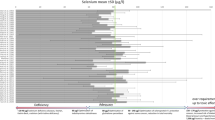Summary
The selenium content of food exhibits great regional differences. Food samples of infants and young children from the North Rhine-Westphalia State in the Fed. Rep. of Germany were analysed by instrumental neutron activation analysis and showed that the average selenium content of local vegetable and fruit is below 5 ng/g wet weight. Only samples of potatoes and bananas exhibit higher selenium contents. The bananas, probably imported from different areas of the world, show an extremely high variance with values between 4 and 164 ng Se/g. Commercially available ready-for-use meals for infants or young children have a low Se content (median 24 ng/g) which is comparable to cow's milk. Besides eggs, cereals enriched with milk and some other cereal products contain more than 100 ng Se/g.
Zusammenfassung
Der Selengehalt der Nahrung weist große regionale Unterschiede auf. Nahrungsproben von Säuglings- und Kleinkinderkost aus Nordrhein-Westfalen wurden mit Hilfe der instrumentellen Neutronenaktivierungsanalyse untersucht und zeigten, daß der Selengehalt der hiesigen Gemüse und Früchte durchschnittlich etwa 5 ng/g beträgt. Nur Proben von Kartoffeln und Bananen weisen einen höheren Selengehalt auf. Bananen, importiert aus verschiedenen Gebieten der Erde, zeigen eine extrem hohe Schwankungsbreite mit Werten zwischen 4 und 164 ng Se/g. Fertiggerichte für Säuglinge und Kleinkinder haben einen der Kuhmilch vergleichbar niedrigen Selengehalt von durchschnittlich 24 ng/g. Außer Eiern enthalten nur Milchbreie und einige andere getreidehaltige Produkte mehr als 100 ng Se/g.
Similar content being viewed by others
References
Arthur D (1972) Selenium content of Canadian foods. Can Inst Food Sci Technol J 5:165
Chen Xi, Yang G, Chen J, Chen Xu, Wen Z, Ge K (1980) Studies on the relations of selenium and Keshan disease. Biol Trace Element Res 2:91
Douglas JS, Morris VC, Soares JH, Jr., Levander OA (1981) Nutritional availability to rats of selenium in tuna, beef kidney, and wheat. J Nutr 111:2180
Hadjimarkos DM, Bonhorst CW (1961) The selenium content of eggs, milk, and water in relation to dental caries in children. J Pediatr 59:256
Hofsommer H-J, Bielig JJ (1980) Die Bedeutung des Selens und dessen analytische Erfahrung in Obst- und Gemüseprodukten. Deutsche Lebensmittel-Rundschau 76:419
Kasperek K (1974) Analytical techniques for the determination of 20 trace elements in biological samples by means of instrumental thermal neutron activation analysis. In: Proc of the 2nd Internat Conf on Nuclear Methods in Environmental Research. US Energy Research and Development Administration Conf 740:701
Lane HW, Taylor BJ, Stool E, Servance D, Warren DC (1983) Selenium content of selected foods. J Am Diet Ass 82:24
Lombeck I, Kasparek K, Bonnermann B, Feinendegen LE, Bremer HJ (1978) Selenium content of human milk, cow's milk and cow's milk infant formulas. Eur J Pediatr 129:139
Lombeck I, Ebert KH: unpublished data
Morris VC, Levander OA (1970) Selenium content of foods. J Nutr 100:1383
Noda K, Hirai S, Danbara H (1979) Selenium contents of Japanese foodstuffs by neutron activation analysis. J Jap Soc Food and Nutr 33:93
Oelschläger W, Menke KH (1968) Ober Selengehalte pflanzlicher, tierischer und anderer Stoffe. 2. Selen- und Schwefelgehaltc in Nahrungsmitteln. Z Ernährungswiss 9:216
van Rij AM, Thomson CD, McKenzie JM, Robinson MF (1979) Selenium deficiency in total parenteral nutrition. Am J Clin Nutr 32:2076
Sakurai H, Tsuchiya K (1975) A tentative recommendation for the maximum daily intake of selenium. Environ Physiol Biochem 5:107
Suchkov BP (1976) Selenium content in the basic food products of the population of the Ukrainian SSR. Pittsburgh, Industrial Health Foundation p. 26
Sunde RA, Gutzke GE, Hoekstra WC (1981) Effect of dietary methionine on the biopotency of selenite and selenomethionine in the rat. J Nutr 111:76
Thorn J, Robertson J, Buss DH, Bunton NG (1978) Trace nutrients. Selenium in British food. Br J Nutr 39:391
Zabel NL, Harland J, Gourmican AT, Ganther HE (1977) Selenium content of commercial formula diets. 3rd International Symposium on trace element metabolism in man. 25–29th of July, Freising-Weihenstephan (Proceedings)
Author information
Authors and Affiliations
Rights and permissions
About this article
Cite this article
Ebert, K.H., Lombeck, I., Kasperek, K. et al. The selenium content of infant food. Z Ernährungswiss 23, 230–236 (1984). https://doi.org/10.1007/BF02021475
Received:
Published:
Issue Date:
DOI: https://doi.org/10.1007/BF02021475



